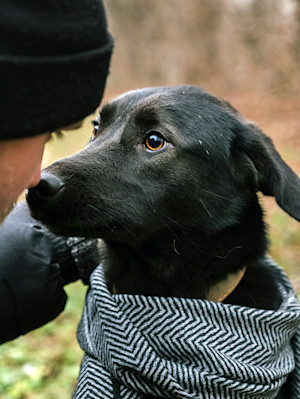Remedies for Pink Eye in Dogs
Because you’re gonna want to clear that up right away.

Share Article
In This Article:
Pink Eye in Dogs Symptoms of Dog Pink Eye Home Treatment for Pink Eye in Dogs How to Treat Pink Eye in Dogs
Wait, dogs can get pink eye? Yep, and it’s just as uncomfortable for them as it is for you. Many pet parents are surprised to learn that dogs can get some of the same conditions humans do, including pink eye.
Farting-on-pillow jokes aside, spotting the symptoms and knowing how to treat pink eye in dogs (at home and with guidance from your vet) can keep your dog comfortable and speed their recovery.

Pink eye in dogs
The conjunctiva is the thin, clear layer that covers the eyeball and the inside of the eyelids. It serves as a protective layer and keeps the eye lubricated. Canine conjunctivitis, or pink eye, refers to inflammation of the conjunctiva.
Dogs can get conjunctivitis for many reasons, and depending on the cause, the condition can develop in one or both eyes. Common causes of pink eye in dogs include:
Allergies
Viral infection
Anatomical changes (cherry eye, eye lid masses)
Entropion (eyelids that roll inwards)
Extropion (droopy eyelids)
Trauma/foreign bodies
Immune-mediated disease
Parasites
Environmental irritants
Symptoms of dog pink eye
When the eye’s natural protective layer is disturbed, it can lead to discomfort, changes in appearance, and disruptions in how the eye normally functions. Just think about how it feels when you get an eyelash in your eye — it’s pretty obvious something is up. Dogs have obvious signs of eye irritation, too.
So, if you’re looking at your dog thinking, “my dog’s eyes are goopy, itchy, and kinda red — could this be pink eye?” The answer is: Yeah, maybe. Signs of pink eye in dogs include:
Eye redness
Squinting
Frequent blinking
Pawing or rubbing the eyes
Swelling around the eyes
Eye discharge (clear, mucoid, yellow, or green)
Raised third eyelid
Nasal discharge
Home treatment for pink eye in dogs
If your dog is displaying signs of pink eye at home, the best course of action is to have them checked out by your vet to try to determine the underlying cause and make sure the correct treatment is started as soon as possible.
Eye issues that are left untreated, or are started on the wrong treatment, can worsen to the point where they can affect vision. So don’t mess around trying different home remedies for pink eye in your dog if you don’t know the cause. Go to your vet for guidance.
That said, there are some things you can do at home to help your dog recover:
E-collar
When I diagnose dogs with conjunctivitis, one of the things I often tell dog parents is that the cone collar is almost as important as the medications. What’s the point of treating one problem if your dog is going to rub and scratch until they cause another? Constant rubbing and scratching can cause corneal abrasions and ulcers. So, place a cone collar to keep your dog from bothering their eyes so they can actually heal.
Gentle cleansing
Gently wiping away your dog’s goopy eye boogers or dried crusts can help them feel more comfortable. Moisten a wash cloth, paper towel, or cotton round with warm water, then gently wipe the skin around the eyes.
Warm compress
A warm compress is a home treatment for pink eye in dogs that your pup may appreciate. Moisten a wash cloth with warm water and gently hold it on top of your dog’s eye for a few minutes. This can help provide comfort and has the added benefit of loosening dried crusts on your dog’s face to ease removal.
Saline eye wash
Sterile saline eye wash can be used as an over the counter pink eye treatment for dogs, though it’s not a replacement for medicated eye drops that your vet may prescribe. You can flush your dog’s eyes once or twice daily to remove irritants from the eyes. Speak to your vet before doing this, because flushing may not be recommended depending on the condition of your dog’s eyes. Be sure to only use sterile saline eye wash. Not contact solution. Not Visine.
Artificial tears
Not to be confused with saline eye wash, artificial tears can help lubricate your dog’s eyes and provide protection and relief. Artificial tears can be particularly helpful for dogs with pink eye secondary to keratoconjunctivitis sicca (KCS), or dry eye. Just check with your vet before using them so they don’t interfere with any other eye drops your dog might be on.
Limit exposure to irritants
Keep your dog away from smoke, dust, strong cleaning products, or allergens like pollen — all of which can worsen symptoms or delay healing.
Grooming
Keeping the fur around your dog’s eyes trimmed and clean can help prevent hair from irritating the eyes or introducing bacteria.
How to treat pink eye in dogs
It’s rare for dogs to develop pink eye without some other underlying cause, like allergies, dry eye, or eyelid abnormalities. So, if your dog has symptoms of pink eye, seek veterinary care to get a diagnosis and make sure that a correct treatment plan is in place.
Your vet will start with a physical exam and will take a close look at your dog’s eyes for foreign material or anatomical abnormalities, like eyelids rolling inward (entropion) or outward (extropion). Then, direct eye testing may be recommended. This can include Schirmer tear testing to rule out KCS (dry eye) or staining to look for signs of corneal scratches or ulcer.
If your vet thinks the problem could be stemming from an underlying systemic issue, the evaluation may include looking for signs of allergies or testing for infection.
Treatments for pink eye in dogs may include:
Prescription eye drops: Eye drops may contain antibiotics, antihistamines, steroids, immunosuppressants, or other active ingredients to target specific issues.
Allergy treatment: This may include oral medications, bathing, or allergy shots.
Deworming: Flies can transit Thelazia, a parasite that can live in a dog’s conjunctiva and tear ducts.
Surgery: Corrective surgery may be recommended if a dog is experiencing chronic conjunctivitis from eye lid abnormalities.
When to seek expert help
Never hesitate to contact your vet if you’re concerned about your dog’s eyes. Starting natural remedies for pink eye in your dog before getting professional advice can delay proper treatment, which can delay healing and threaten your dog’s vision. Better to play it safe and get a proper diagnosis early.
Seek immediate care if you notice any of these signs:
Bleeding around the eyes
Change in the appearance of the eyes
Sudden blindness
Bottom line
Dogs can get conjunctivitis, aka “pink eye,” for many reasons. Symptoms tend to be obvious: red, itchy, goopy eyes. But treatment can vary depending on the cause. While there are some things you can do at home, having your vet set up a treatment plan will help your dog heal and feel better faster.
References
Cleveland Clinic. “Conjunctiva: Anatomy, Function & Common Conditions.” Cleveland Clinic, 22 Oct. 2022, my.clevelandclinic.org/health/body/24329-conjunctivaopens in new tab.
Hamor, Ralph E. “The Conjunctiva in Animals.” MSD Veterinary Manual, 2 Feb. 2023, www.msdvetmanual.com/eye-diseases-and-disorders/ophthalmology/the-conjunctiva-in-animalsopens in new tab.
CVPM, Sandy Walsh, RVT. “Diagnosing, Treating, and Managing Causes of Conjunctivitis in Dogs and Cats.” Today’s Veterinary Practice, 9 Apr. 2021, todaysveterinarypractice.com/ophthalmology/conjunctivitis-in-dogs-and-cats/opens in new tab.

Dr. Alycia Washington, DVM, MS
Alycia Washington is a small-animal emergency veterinarian with over 10 years of experience based in North Carolina. She works as a relief veterinarianopens in new tab and provides services to numerous emergency and specialty hospitals. She also works as a veterinary writer with a focus on educating pet parents.
Related articles
Cherry Eye in Dogs: Why Is Your Dog’s Eye So Red?
That would be a cherry eye, and you’ll want to see your vet.
![a dog walking with their parent at night]()
Why Do Dogs’ Eyes Glow in the Dark?
The reason for your midnight jump-scare? Turns out it’s just your dog’s spooky eyes.
Cloudy Eyes in Dogs: Causes, Risks, and How to Manage Vision Changes
There are a few possible reasons for your pup’s murky stare.
Can Your Dog Get Pink Eye?
You won’t like the answer, but thankfully there’s a solution.
![Man looking at his dog's eyes outside.]()
Conjunctivitis in Dogs: How to Identify and Treat Pink Eye at Home
Don’t worry—with a vet’s help, things will be OK.
![Cute small dog covering eyes with paws.]()
Canine Eye Infections: How to Treat Your Dog’s Eye Infection
They aren’t fun, but you can’t leave them alone.







